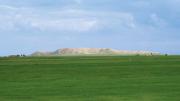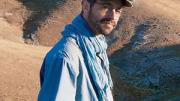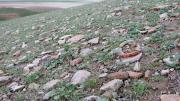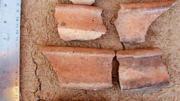The most fascinating thing about the suburbanites living around the ancient Mesopotamian settlement of Tell Brak isn’t who they were, according to archaeologist Jason Ur, but how they joined the city.
While studying the site in what is today northeastern Syria, a few hundred miles north of Gilgamesh’s Uruk (Tell Brak’s most celebrated contemporary), the assistant professor of anthropology discovered something surprising: instead of growing from the inside out, Tell Brak apparently expanded when settlements outside its borders slowly grew into it. “Near Eastern archaeologists have this idea that the origins of cities are based on the power of a single man, or centralized political power,” says Ur. But around Tell Brak, the immigrants (which is what Ur believes they were) kept “some autonomy from the preexisting community. Which is not the prevailing model.”
Archaeologists including Max Mallowan (better known as the husband of mystery writer Agatha Christie) have been digging up Tell Brak’s secrets since the 1930s. Thousands of years of human history lie buried under the artificial mound that protrudes some 40 meters—roughly 10 stories—into the air from the center of the otherwise flat 2-by-1.5 kilometer site. (“Tell” derives from tall, Arabic for “hillock.”) A group of Cambridge University scholars began excavating the mound in the late 1970s, burrowing down through the strata of the third and fourth, and finally the fifth, millennium B.C.
Ur—whose colleagues jokingly accuse him of using a stage name—joined the Cambridge team in 2002. Besides digging, the excavation project was also surveying the wider region for distant neighbors, but Ur proposed to study the area right around the mound. After gaining the local landowners’ permission, he spent three seasons (which last from May to September) doubled over, walking back and forth across the site. He began each day as soon as it was light enough to see, took a siesta in the afternoon when the temperature crept above 100 degrees, and continued in the early evening while the sun went down. It wasn’t always fun “walking through farmers’ fields and being chased by the dogs and kicking sheep dung off the surface, looking for tiny potsherds.”
Potsherds are the ancient debris of daily life, bits of earthen storage vessels and cooking pots that litter the ground—Ur estimates there may be something like 10 million pieces on the site. Every year the farmers’ plows turn up more. Simply by looking at their characteristics, such as decorative patterns or coloration (which varies according to kiln heat), Ur can date them. (He likens it to dating cars by their fins, hand cranks, or hybrid engines.) For example, in the early fourth millennium B.C., Mesopotamians tempered their clay with sand. Later, they replaced the sand with vegetable matter, such as ground-up chaff, impressions of which remained on the finished pottery after firing.
Ur found small, concentrated pockets of sherds from the late fifth millennium some 1,000 meters to the southwest and 500 meters to the north and east of the central mound. Around these three areas he found much larger numbers of sherds that date from the middle of the fourth millennium. He concluded that satellite communities had sprung up and expanded naturally, a finding he published in an August 2007 issue of Science magazine. “This pattern,” he wrote, “suggests a greater role for non-centralized processes in the initial growth of Brak and lesser importance for centralized authority.” Perhaps the immigrants couldn’t forcibly integrate themselves into the city—or possibly the city-dwellers lacked the strength to kick them out altogether. In either case, Ur says, there was a balance, rather than a monopoly, of power: a distinct contrast to the older hypothesis based on the famous king of Uruk who, according to the Epic of Gilgamesh, had the literal and political muscle to build a wall around the city and stood alone as a “mighty net, protector of his people.”
For nearly 20 years, the political situation in Iraq has made it next to impossible to study the ancient cities of southern Mesopotamia. The assumption is that the dozen or so settlements in Iraq follow the Gilgamesh model: a strong central leader. But whenever archaeologists return to these sites, Ur suspects they may find something more complicated. “I shouldn’t say that what we find at Brak disproves this inward-outward growth model,” he says. “But it certainly suggests, at the minimum, that there were multiple paths to urbanism.”













